Innovation for an aging society: Shenzhen rides the'silver economy' wave
Writer: Zhang Yu | Editor: Lin Qiuying | From: Original | Updated: 2024-11-04
The world’s second largest economy is rapidly aging. At the end of 2023, China had 297 million people aged 60 and over — 21.1% of the total population. This number is expected to exceed 400 million around 2035 — over 30% of the total population — according to the National Health Commission.
While the average age of Shenzhen residents is 32.5 years old, the city had more than 1.38 million permanent residents aged 60 and above by the end of 2023, which accounted for 6.95% of the city’s permanent population.
By 2029, it is projected that the permanent population of adults aged 60 and over in Shenzhen will reach 1.49 million, or 10.52% of the city’s permanent population, thus marking Shenzhen’s official entry into an aging society — a threshold defined in China as 10% of the population being aged 60 and above.
To address this demographic shift, China has introduced guidelines to actively boost the “silver economy,” which is defined as the production, distribution, and consumption of goods and services targeting people aged 60 or older.
In Shenzhen, a globally renowned technology hub, accessible smart healthcare products and services are helping an increasing number of older adults age gracefully and live comfortably in their silver years.

Booming silver economy
According to the 2024 government work report delivered by Chinese Premier Li Qiang this March, China is working to enhance the provision of goods and services for senior citizens and promote the development of the silver economy, which presents new growth opportunities across various sectors.
In 2024, the size of China’s silver economy is estimated to be around 7 trillion yuan (US$981.8 billion), equivalent to 5.5% of China’s GDP in 2023. By 2035, the market is projected to reach 30 trillion yuan.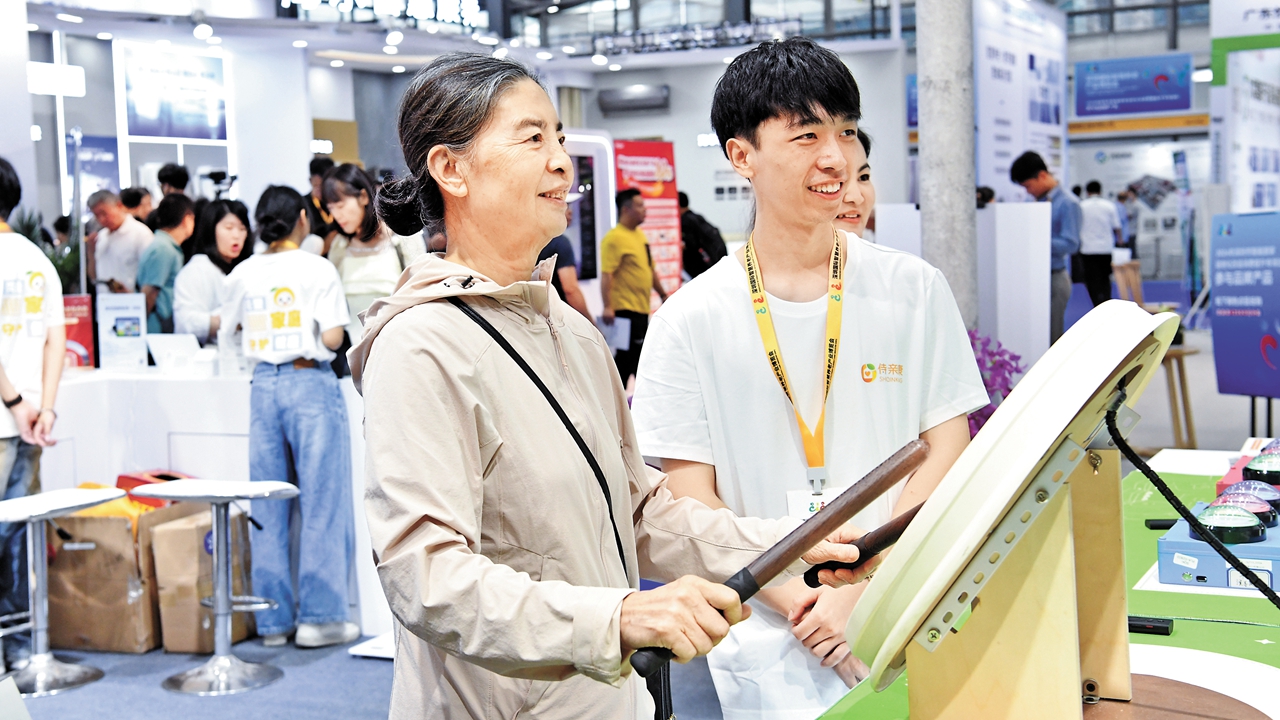
A visitor uses an elderly care device at the 2024 Shenzhen International Intelligent Elderly Care Industry Expo, which took place at the Shenzhen Convention and Exhibition Center in Futian District from Oct. 25 to 27. Photos from Xinhua except otherwise stated
Shenzhen’s major enterprises are already capitalizing on opportunities within the silver economy. Smart technology products are now commonplace not only in various senior citizen service centers and nursing homes throughout the city, but also in the homes of ordinary residents.
For instance, Shenzhen-based robotics company UBTECH has introduced a series of robots aimed at addressing challenges such as the shortage of caregivers, the global growth of aging populations, and the rising demand for high-quality healthcare services.
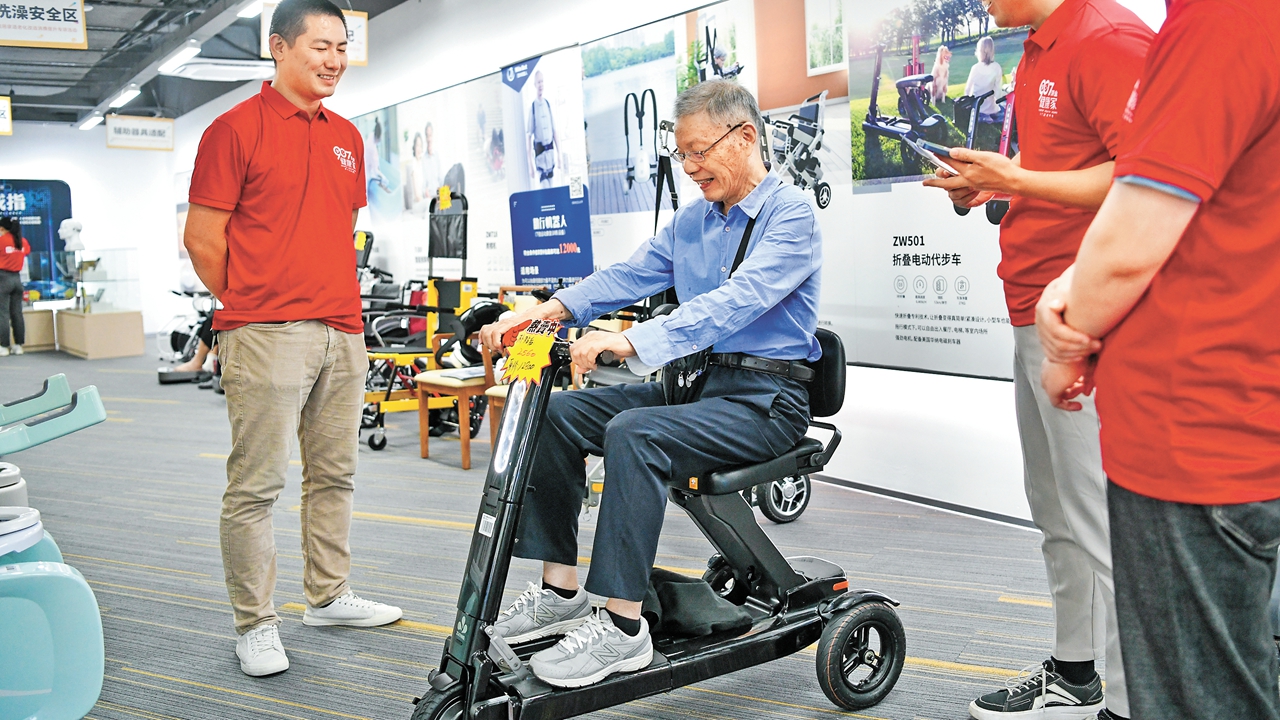
A potential buyer tries out an electric scooter at a shopping mall dedicated to elder care products in Nanshan District.
“We hope to integrate different forms of products into smart senior care scenarios, provide integrated services, and accurately identify the needs for robots in senior care services,” said Tan Huan, UBTECH’s chief technology officer and general manager of UBTECH’s healthcare business unit.
Tencent’s “invisible caregiver” AI care system has leveraged the tech giant’s core technologies in AI, cloud computing, and Internet of Things to create a pioneering video and voice dual-mode system for home safety monitoring. According to the company, the system boasts a success rate exceeding 90% in accurately identifying and triggering alarms when seniors fall or require assistance.
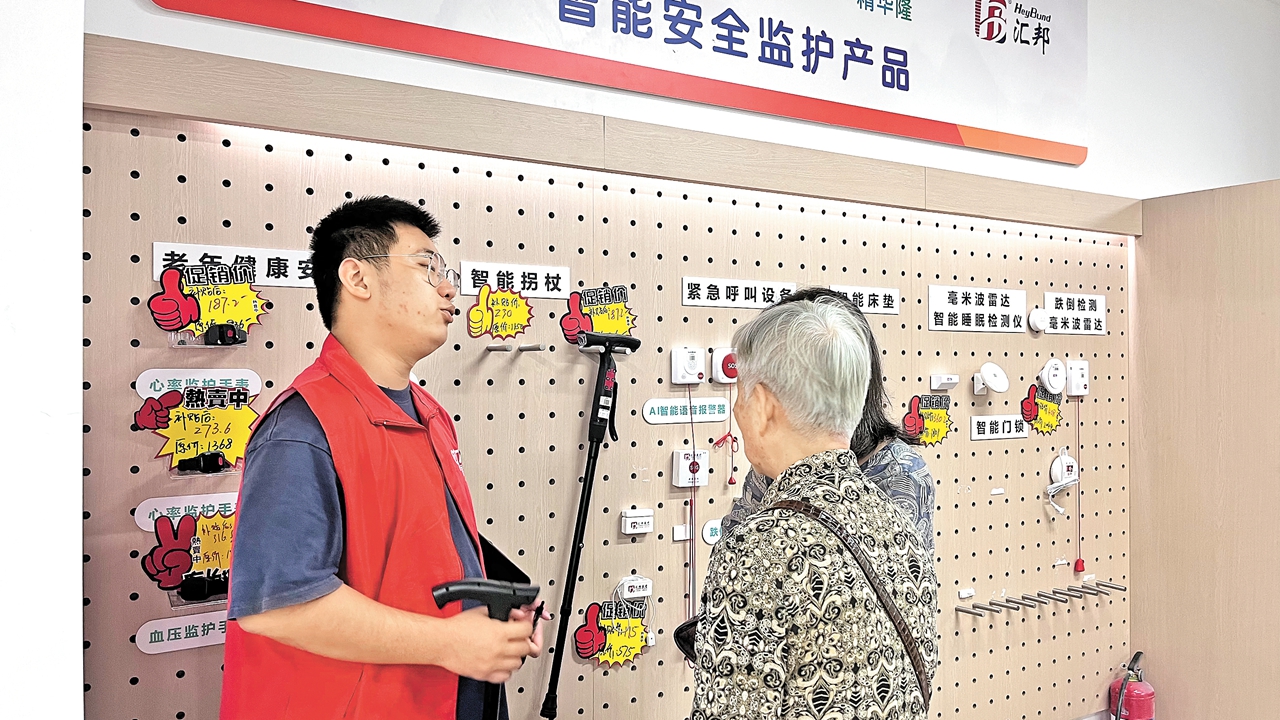
A salesman demonstrates different intelligent products help safety monitoring.
TV manufacturer Skyworth’s coocaa P60 series can detect vital signs such as heart rate and blood oxygen levels within 10 seconds. Users can access five health metrics and reports, including blood oxygen, heart rate, respiratory rate, microcirculation, and fatigue levels, within 30 seconds on the device’s large screen with a touch on the remote control.
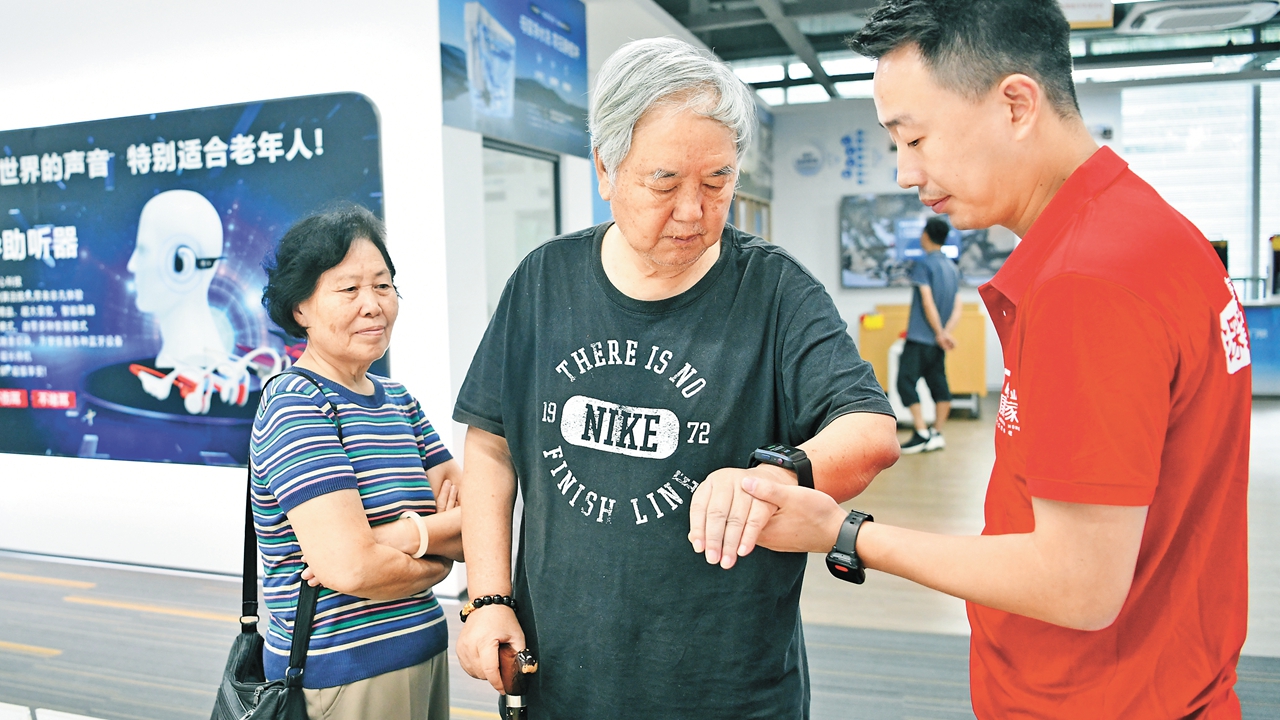
A potential buyer tries out a watch with various functions.
The Shenzhen-headquartered Ping An Group, China’s largest insurer by market capitalization, has also recognized extensive potential in leveraging technology to enter the silver economy. In 2021, the insurer introduced a home-based senior care service platform that integrates intelligent solutions, online and in-person medical services, and lifestyle offerings.
Proactive government initiatives
Despite its reputation as a youthful city, Shenzhen is taking early action and implementing comprehensive plans to support its aging population, aiming to create an elder-friendly environment that helps seniors live well as they age.
At the 2024 Shenzhen International Intelligent Elderly Care Industry Expo, 203 exhibitors from home and abroad showcased more than 1,000 products and technologies for elder care from Oct. 25 to 27. For the second consecutive year, Shenzhen hosted the expo to promote smart elder care solutions that meet consumer needs, offering high-quality, elder-friendly solutions to help the aging population adapt to the digital age.
The expo was linked to a municipal home modification campaign, during which 31 participating companies exhibited and sold nearly 400 smart elder care products on-site. Eligible elders could receive subsidies of up to 12,000 yuan when purchasing elder-friendly products using their subscription code.

A senior visitor uses a massage armchair at the 2024 Shenzhen International Intelligent Elderly Care Industry Expo at the Shenzhen Convention and Exhibition Center in Futian District on Oct. 26. Photo by Zhang Yu
Additionally, a shopping mall dedicated to elder care products, the first of its kind in the Guangdong-Hong Kong-Macao Greater Bay Area, opened in Nanshan District in mid-October. Operated by a subsidiary of the Shenzhen government-owned Shum Yip Group, the 1,097-square-meter mall provides a one-stop solution for intelligent products and home modifications, showcasing elder-friendly model rooms and offering subsidies of up to 12,000 yuan for eligible seniors purchasing products.
Moreover, with the support of special ultra-long-term treasury bond funds, Shenzhen plans to subsidize purchases of intelligent products by permanent residents aged 60 and over, with eligible families receiving a maximum of 20,000 yuan.

A salesman demonstrates how to use an electric stand-up walker with seat at a shopping mall dedicated to elder care products in Nanshan District. It is the first of its kind in the Guangdong-Hong Kong-Macao Greater Bay Area.
In fact, since 2020, the city’s civil affairs bureau has piloted home modifications for seniors, offering a subsidy of up to 10,000 yuan per household for items like walk-in tubs, handrails, wireless call systems, hospital beds, and wheelchair ramps.
To meet the needs of elder people for home-based care, Shenzhen has also created a smart elder care service platform. “Our intelligent call service center has connected 38,000 devices and over 8,000 households, providing call and assistance services for these households,” said Ni Chidan, deputy general manager of the Shenzhen Wellbeing and Wellness Industry Group.
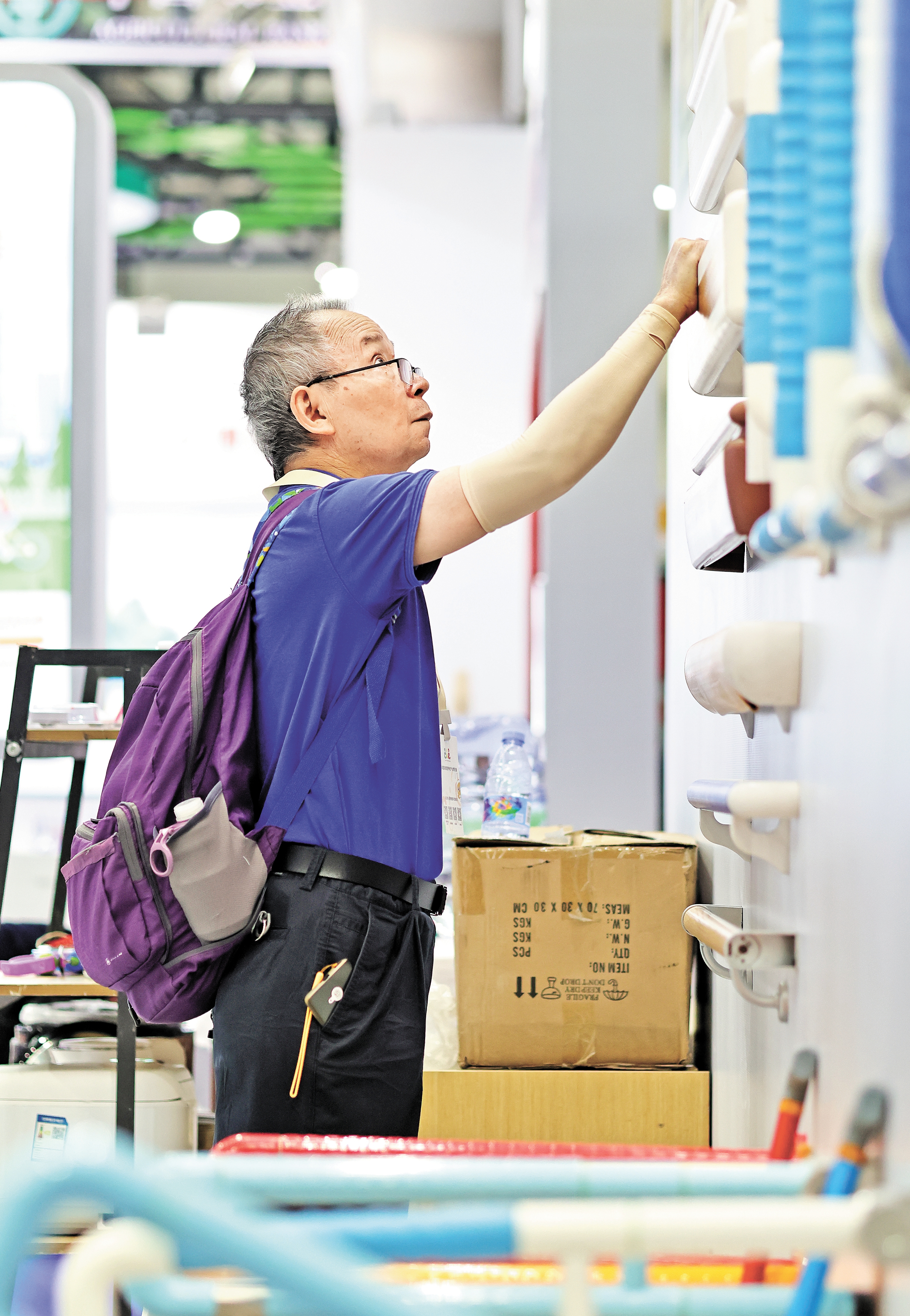
A senior visitor shows interest in products on display.